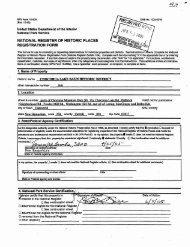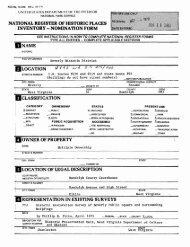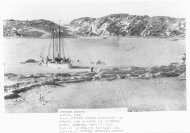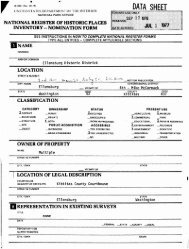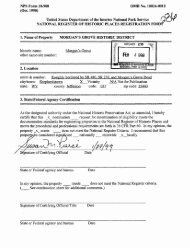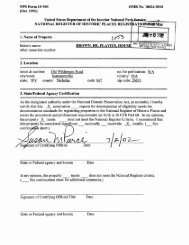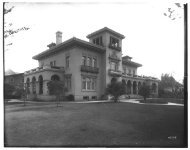National Register of Historic Places Continuation Sheet
National Register of Historic Places Continuation Sheet
National Register of Historic Places Continuation Sheet
Create successful ePaper yourself
Turn your PDF publications into a flip-book with our unique Google optimized e-Paper software.
NPS Form 10-900-A 0MB Approval No. 1024-0018 (8-86)<br />
United States Department <strong>of</strong> the Interior<br />
<strong>National</strong> Park Service<br />
<strong>National</strong> <strong>Register</strong> <strong>of</strong> <strong>Historic</strong> <strong>Places</strong><br />
<strong>Continuation</strong> <strong>Sheet</strong><br />
Section Number: _7_ Page: 10 Geneva-Minnesota <strong>Historic</strong> District, Medford, OR<br />
transferred to Marvin Mitchell, the couple's son, although his parents apparently at the address until<br />
its 1930 sale to John C. and Nina Boyle. 19<br />
John C. Boyle was a noted engineer serving as the Chief <strong>of</strong> Engineering for COPCO when he, his<br />
wife, and their two daughters returned to Medford from Klamath Falls in 1930. Boyle, born in<br />
Siskiyou County, California has been credited with designing every single hydroelectric generating<br />
facility built in the southern Oregon-northern California period for the first 60 years <strong>of</strong> the region's<br />
commercial power generation history. Prominently associated with the North Umpqua Hydroelectric<br />
Project in Douglas County and the Klamath Basin Project, the latter was renamed in his honor in<br />
1963, upon his retirement. 20 Boyle recorded his recollections <strong>of</strong> hydroelectric development in<br />
southern Oregon in two books, Toketee and Fifty Years on the Klamath, that remain pivotal<br />
references in documenting that area <strong>of</strong> the region's history. In 1937, after renting the house for a<br />
time to Karl Janouch, Supervisor <strong>of</strong> the Rogue River <strong>National</strong> Forest, the Boyles sold the Geneva<br />
Street property to an automobile distributor, Walter W. Abbey, and moved to another Medford<br />
residence. 21 Subsequent owners <strong>of</strong> 28 Geneva include Frank W. Humphrey, a prominent automobile<br />
dealer in the Medford area.<br />
The Mitchell-Boyle House remains substantially intact to its original design and appearance. The<br />
original concrete retaining wall and entry steps have been replaced with a pebble-finish wall that is<br />
stepped back from the street, deviating from the common placement <strong>of</strong> the remainder <strong>of</strong> the block,<br />
somewhat impacting the uniform nature <strong>of</strong> this side <strong>of</strong> Geneva. However this does not seriously<br />
diminish the structure's ability to successfully convey its original development.<br />
Way," apparently an small alley connecting North Central and North Bartlett Streets no longer survives on<br />
city maps.<br />
19 See JCD 178:293, 5-July-1922 and JCD 184:587, 14-0ctober-1930.<br />
20 Following COPCO's 1961 merger, Boyle was again working in association with Paul McKee, former<br />
President <strong>of</strong> COPCO and Geneva Street resident. It was McKee who authorized the renaming <strong>of</strong> the<br />
Klamath River facility the John C. Boyle Hydroelectric Project in honor <strong>of</strong> his half-century <strong>of</strong> service to the<br />
southern Oregon region.<br />
21 See "Geneva Street Home is Bought by Abbey," Medford Mail Tribune, 14-May-1937, 8:2. The Boyle's<br />
moved to 1917 East Main Street, a house listed in the NRHP in 1982 as the "Frank Chamberlain House"<br />
after its first owner and architect.



